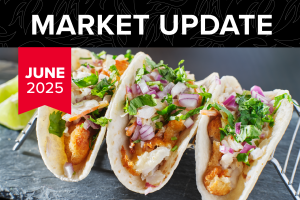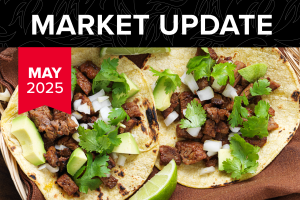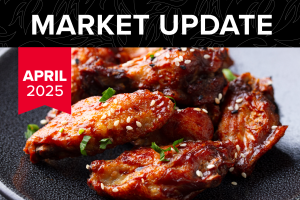Your monthly update on the state of the pork, poultry, beef, and seafood industries, direct from the category experts at Y. Hata.
Poultry
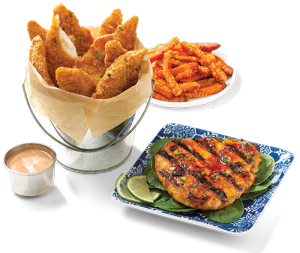
Transportation challenges continue to hamper poultry processor’s ability to get product shipped throughout the country in a timely and efficient manner. Whether it is trucks or rail cars, delays are common and is expected to continue through the end of this year. The tornado that ripped through Kentucky damaged 2 of Pilgrim’s Pride hatcheries and that is expected to cause a delay in the raising and processing of chickens impacting the overall market in the short-term.
In October, Tyson Foods announced a 21% wage increase for their NW Arkansas plants and this week upped the ante and will give out $50 million in year-end bonuses. Tyson Foods is also looking at ways to improve their health benefits, flexible work schedules and childcare needs, and this is expected to move other chicken processors to improve their wages and benefits helping to retain workers. These improvements mean an increase in labor cost. Combined with an increase in transportation, packaging, feed and energy, it is difficult to see prices reverting back to pre-covid levels even when the overall environment improves.
- Demand for Whole Fryers and Grillers in the 4/lbs. and smaller size continues to be strong and it is getting more and more difficult to uncover at reasonable price levels. Pilgrim’s Pride is a large supplier of smaller WOG’s for the Foodservice industry and the damage from the tornado has further impacted supply.
- As shared last month, Jumbo wings did soften in price but quickly reversed course and moved back up but slightly under the previous price. Offers were quickly bought up and now most are sold under contractual agreements.
- The packers continue to say Tray Pack Thighs will be available soon, but the offers are limited to non-existent. We are getting about 25% of our normal supply.
- BL SL Thigh prices continue to trend down but at a slower rate which could mean we are nearing the bottom.
- Skin on legmeat supply has improved with prices decreasing but we’ve yet to see that same trend with our Mountaire brand which is processed in North Carolina. Mountaire continues to see labor challenges and combined with rail car issues when moving product to the west coast, their prices have moved up slightly.
Pork
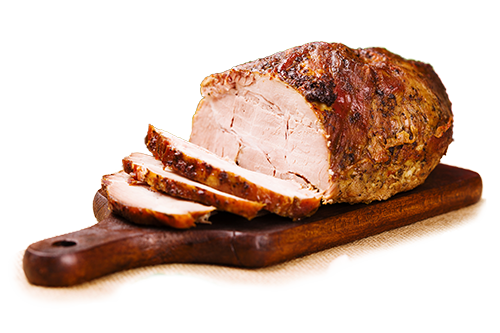
Heading into the last two weeks of the year the demand centers around Ham, Ribeye and Turkey so pork interest is limited, and prices are steady to weaker. What is unknown is the damage in the Midwest caused by the extreme weather and how that will impact the packers and farmers
- Bellies are expected to be weaker as seasonal demand has declined.
- The steep price decline in Bone-in and Boneless pork has slowed and may be approaching the bottom. Although butts have dropped significantly, they are still $.50/lbs. higher than the low in 2019 The same factors impacting the poultry market such as increases in labor, transportation, packaging, feed, and energy costs are impacting their pork friends.
Both the Poultry and Pork industries expect the supply to improve in January but are wary of increases in various costs. Coupled with general inflation, consumer may start altering what they purchase.
Beef
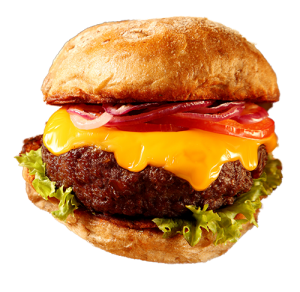
Supply constraints and the continued labor shortage remain the primary challenges facing all beef packers. The ongoing Omicron COVID-19 variant has only added more uncertainty as we approach the end of the year. With domestic and international buyers focused on just securing product, pricing is secondary, and we should expect high prices to persist in 2022.
- Prime graded beef which already had poor availability has become even more challenging to source due to the elevated holiday demand. We should expect high pricing for the remainder of the year and well into the new year.
- Pricing for beef trimmings which are used to produce ground beef, beef patties, sausages, etc. had stabilized but are now increasing with cost conscious consumers moving away from more expensive roasts/steaks and gravitating towards lower cost processed meat items.
- Ribeye pricing has remained unseasonably soft as we approach the Christmas and New Year holidays with most buyers worried about availability having already secured their needs in late summer to early fall. However, these lower prices have started to attract the attention of retailers who are looking to feature ribs for future ads in January leading up to the Super Bowl weekend.
- Striploin pricing has continued to decrease although we are not quite at pre-Covid levels yet.
- Brisket prices are at unprecedented levels largely due to manufacturers securing raw material in preparation for St. Patrick’s Day.
- Flap meat prices have remained steady, and we do not expect any significant increases as consumers are focused on holiday roast items.
- Chuck roll prices have come off another $.40/lbs. to $.50/lbs. this month but are still at historically high levels.
- Chuck flat pricing will be decreasing by $.11/lbs. for January, but international demand continues to remain robust. Additionally, all grades of chuck flat remain hard sold as we head into 2022 even at these crazy prices.
- Short Rib prices will be decreasing slightly in January, but we are still facing limited availability.
- Oxtail prices continue to remain at elevated levels with no signs of softening as we are amid the winter months with peak demand.
With inflation expected to remain high in the new year the pricing outlook for the beef industry remains uncertain as we await how consumer spending unfolds in 2022.
Seafood
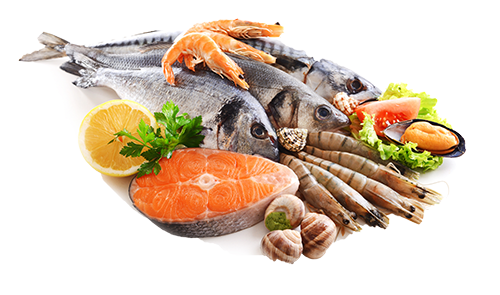
As noted last month, the majority of seafood items we sell are imported from overseas and not much has changed regarding shipping delays and high transportation costs. In fact, despite lower volume into the Port of Los Angeles in November, the capacity of ships waiting to dock increased in November and December.
On an Agri Briefing webinar last week logistics analysts shared the following:
- Frozen container shipping from Asia to the US increased in price from $3,000 to over $25,000.
- Frozen container shipping from Asia to Europe increased in price from $1,500 to over $15,000.
- Labor issues continue at all ports around the world.
- One of China’s ports recently shut down for 10 days due to Covid issues – they average 300,000 containers a day or 3 million containers over that 10-day period.
- Logistic issues will continue well into 2022.
Here’s an update on a few key items
- King Crab – Demand for live King Crab remains strong which is keeping prices for frozen crab high. We saw a slight dip in prices yesterday, but we don’t know if that trend will continue.
- Snow Crab – As shared each month we are well positioned on 5/8 and 8/UP Clusters and prices are stable through the Holidays.
- Lobster – We bought a fair amount of 4 oz., 4/5 oz. and 6/7 oz. North Atlantic Tails and prices have been steady the past month. For the most part the fishing season has stopped due to the cold weather which means prices may tick up short term. We’ll have to see what next season’s catch, around May 2022, will look like in terms of volume and prices.
- Yellowfin/Ahi – Good news – our container of Poke Cubes, Mini Cubes, Saku Blocks and Steaks docked into Honolulu harbor yesterday and has cleared FDA and US Customs. We are now waiting for the container to be picked up, unloaded, and staged for us to pick up. We anticipate that to be around Dec 23rd, but it may delay until after Christmas. The Bad News – the packer mixed our order up and instead of 1,300 cs. of Poke Cubes and 500 cs. of Mini Diced Cubes, we are getting 500 cs. of Poke Cubes and 1,300 cs. of Mini Cubes.
- Around the world packers and processors continue to grapple with the ongoing effects of Covid and the shortage of labor, add in the disaster of logistics and it’s difficult to see any near-term improvements.
As mentioned earlier in a webinar with Agri Briefing, two statements caught my attention:
- Today, “Product Availability Is Priority, Price Is Secondary”. If the US is not willing to pay for it, another country will.
- In today’s world it is no longer “Just in Time”, it’s changed to “Just in Case”.

